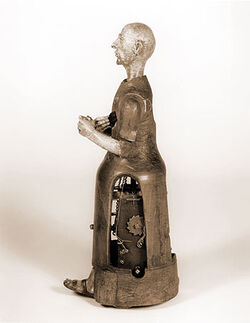Didacus automaton (nonfiction)
From Gnomon Chronicles
The Didacus automaton is a mechanical model of Didacus of Alcalá, commissioned by King Philip II of Spain.
King Philip commissioned Juanelo Turriano, mechanic to Emperor Charles V, to build the clockwork model of Didacus.
The model performs a number of set actions, including the beating of the breast which accompanies the Mea culpa prayer.
It is still in working order and can be seen in the Smithsonian Institution.
Historical theories for why the friar was built include that: Philip II wished to share the miracle of his son's recovery with his people; or the clockwork friar provided a portable model of "how to pray" which could be displayed around the kingdom.
In the News
Fiction cross-reference
Nonfiction cross-reference
External links:
- Didacus of Alcalá @ Wikipedia
- Juanelo Turriano @ Wikipedia - born Giovanni Torriani (c. 1500 — 1585) was an Italo-Spanish clockmaker, engineer and mathematician.
- Clockwork Prayer: A Sixteenth-Century Mechanical Monk

